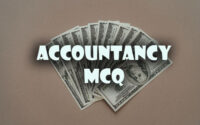Economics Mock Test Papers
1. Under Monopolistic competition the cross elasticity of demand for the product of a single firm would be:
A. infinite
B. Highly elastic
C. Highly inelastic
D. Zero
2. in a free-market economy the allocation of resources ls determined by:
A. Votes taken by consumers
B. A central planning authority
C. By consumer preferences
D. The level of profits of firms
3. The total demand for goods and services in an economy is known as:
A. Aggregate demand
B. Gross national product.
C. Economy-wide demand.
D. National demand.
4. Monopolist can determine:
A. Price
B. Output
C. Either price or output
D. None
5. Under monopoly price discrimination depends upon:
A. Elasticity of demand for commodity
B. Elasticity of supply for commodity
C. Size of market
D. All of above
6. The first fundamental Theorem of Welfare Economics requires:
A. that there be an efficient market for every commodity.
B. that the economy operates at some point on the utility possibility curve
C. producers and consumers to be price takers.
D. All of the above.
7. Consider a small economy where the total population is 10,000. The size of the labour force is 8,000, while the number of people employed is 7,000. What is the unemployment rate in this economy?
A. 10%
B. 12.5%
C. 20%
D. 30%
8. In 2000, the nominal GDP growth of a country was 8% and the real GDP growth was 4%. What was the rate of inflation for this country?
A. -4%
B. 2%
C. 4%
D. 8%
9. The difference between total expenditure and total receipts is
A. Fiscal deficit
B. Budget deficit
C. Primary deficit
D. Revenue deficit
10. What do we call a soft loan that is granted on very favourable terms to the borrower?
A. Concessional Loan
B. Subsidized loan
C. Personal Loan
D. None of the above
11. Which of the following tax is best example of ability to pay principle of taxes?
A. Excise tax on cigarettes
B. Highway toll tax
C. Proportional sales tax
D. Personal income tax
12. A government restriction on quantities of a particular commodity that maybe sold outside nation’s boundaries for a specific period of time is known as
A. export quota
B. import quota
C. quota rent
D. embargo
13. Terms of Trade of a country show ……………
A. Ratio of goods exported and imported
B. Ratio of import duties
C. Ratio of prices of exports and imports
D. Both A. and C
14. Sometime it’s more affordable to purchase a good from companies with than it is to produce good internally is possible only with
A. Outreaching
B. off shoring
C. outsourcing
D. international trade
15. The main difference between a tariff and a quota is
A. A quota reduces the quantity of imports more than a tariff.
B. A tariff raises the price of imports more than a quota.
C. A quota does not ham: domestic consumers.
D. A tariff generates government revenue, while a quota, unless it is sold, does not
16. which of the following factor forms the invisible account of the Balance of Payments of a country?
A. International trade in services.
B. Income associated with non resident assets and liabilities.
C. Remittance of worker income.
D. All the above.
17. Which of the following is not a function of Reserve Bank of India?
A. Regulation of credit.
B. Regulation of foreign exchange.
C. Management of fiscal deficit.
D. Banker to the government and commercial banks.
18. Under flexible exchange rate and perfect capital mobility, an expansionary fiscal policy will lead to an Incipient BOP _________, and the ________ will shift to the ________ to restore equilibrium.
A. deficit; is; left
B. surplus; is; left
C. deficit; LM; right
D. surplus; BP; left
19. In the foreign exchange market, the domestic currency is under pressure to:
A. remain the same
B. depreciate/devaluate
C. appreciate/revaluate
D. none of the above
20. Hard Currency is defined as currency:
A. which can hardly be used for international transactions
B. which is used in times of war
C. which loses its value very fast
D. traded in foreign exchange market for which demand is persistently relative to the supply
21. In India, Paper Currency first started in the year?
A. 1861
B. 1865
C. 1761
D. 1765
22. The gains from International trade depend on the
1. Differences in cost rations in the two trading countries
2. Terms of trade
3. Size of the country
Select the correct answer using the codes given below:
A. 2 and 3 only
B. 1 and 2 only
C. 1 and 3 only
D. 1, 2, and 3
23. Which among the following products is usually not exported from India?
A. Wheat
B. Rice
C. Sugar
D. Pulses
24. What does EMU stand for?
A. European Monetary Union
B. European Macroeconomic Union
C. Economic and Monetary Union
D. Economic and Macroeconomic Union
25. India has approved its first National intellectual Property Rights Policy reiterating India’s commitment to TRIPS. What does TRIPS stand for?
A. The Agreement on Trade Related Aspects of intellectual Property Rights
B. The Agreement on Tender Related Aspects of Intellectual Property Rights
C. The Announcement on Trade Related Aspects of intellectual Property Rights
D. The Agreement on Trade Relation Aspects oi intellectual Property Rights
26. Marshall defines “Economics is a study of mankind in the ……………… business of life and examines that part of individual and social action which is connected with material requisites of well being.”
A. extra ordinary
B. ordinary
C. excellent
D. All of the above
27. The credit of developing the concept of modem economic growth goes to:
A. Arthur Lewis
B. Michael P. Todaro
C. Gunnar Mydral
D. Simon Kuznets
28. Most of the underdeveloped economies suffer from ________ which do not let the rate of growth go up from a lower level.
A. High population pressures
B. High infant mortality
C. Hugh monetary mismanagement
D. High level of technological unemployment
29. By _____________ growth rate of an economy can be speeded up
A. Investment in share market
B. investment abroad
C. Investment in human capital formation
D. Investment in primary sector
30. Which of the following is not an indicator oi economically underdeveloped countries?
A. Low per capita income
B. High death-rate
C. Low proportion of labour force in the primary sector
D. High level of illiteracy
31. Which of the following does not come under land reform?
A. Consolidation
B. Cooperative farming
C. Drip irrigation
D. All of the above
32. Which of the following was included as part of the land reforms initiated in India?
A. Abolition of intermediaries
B. Tenancy reforms
C. Reorganization of agriculture
D. All the above
33. Which of the following was a part of the green revolution strategy?
A. High yielding variety seeds
B. Chemical fertilizers and pesticides
C. Irrigation
D. All the above
34. India opted for ‘Mixed Economy in ____________.
A. First Five Year Plan
B. Industrial Policy of 1948
C. The first Fiscal Policy
D. Planning Commission
35. Indian agriculture is typically characterized as?
A. land surplus, labour scare economy
B. land surplus, labour surplus economy
C. land scare, labour surplus economy
D. land scare, labour scare economy
36. The value of national income adjusted for inflation is called
A. Per capita income
B. Disposable income
C. Inflation rate
D. Real national income
37. The national Income estimation is the responsibility of
A. NSSO
B. CSO
C. Finance Ministry
D. National Income Committee
38. Estimates of national income in India are prepared by the?
A. Ministry of Finance
B. Reserve Bank of India
C. Central Statistical Organization
D. Planning Commission
39. In which of the Five Year Plans, preference was given to the weaker sections of the society?
A. Second
B. Third
C. Fourth
D. Fifth
40. Which of the following institutions is not pert of the World Bank community?
A. IBRD
B. WTO
C. IDA
D. IFC
41. When poverty is taken in relative term and is related to the distribution of income consumption expenditure It is called:
A. Law line poverty
B. Absolute poverty
C. Relative poverty
D. None
42. Which is the method to estimate the poverty?
A. Investment Method
B. Income Method
C. Capital Method
D. Human Method
43. A stationary population is when population growth is
A. increasing at an increasing rate.
B. decreasing.
C. zero.
D. 100%.
44. The greenhouse effect is the phenomenon by which
A. biological diversity is dominant in agricultural production.
B. the globe’s water pollution affects plankton.
C. the earth’s atmosphere traps infrared radiation.
D. climatic changes occur naturally in the forest.
45. Which of the following le disadvantageous to developing countries International trade?
A. Protection
B. Free trade
C. Exports of primary and import of manufactured goods
D. None of the above
46. Which base year is used to calculate per capita income in India?
A. 2004-05
B. 2011-12
C. 2001-2002
D. 2014-15
47. ______________ defined economics as a study of mankind in the ordinary business of life
A. Adam Smith
B. Lionel Robbins
C. Samuelson
D. Alfred Marshall
48. Currency notes and coins are called Flat money because
A. they do not have intrinsic value like gold or silver
B. made on special imported paper
C. they are printed by government
D. exchanged for goods and services
49. GNP mines depreciation is
A. GDP
B. NNP
C. NDP
D. Per capita income


